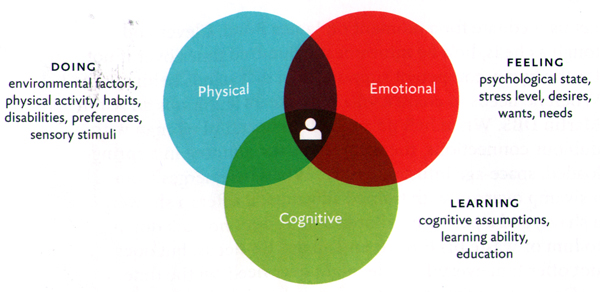You have picked your site and focused on some specific content. How do you know if it is ready to publish?
Make sure your content is appropriate for the target user.
What do I mean by appropriate? I mean your content should be exactly what the user who typed in a specific query is looking for. It should be exactly what they need in just the form they need it. How do you make sure that your content is appropriate? It’s not enough to think of your user’s goals: think of your user’s context as well.
Ask yourself some questions as you try to delve into the mindset of your users:
- What are they doing?
- How are they feeling?
- What are they capable of?
But beware: assumptions about your users, no matter how well-researched, are still just assumptions. Always give your readers the option to see more content if they wish to do so.
Content should also be appropriate for your business goals.
Content is right for your business goals when it helps you accomplish your business goals in a sustainable way. Sure, you are all students, maybe you think you have nothing to sell, but rest assured, you are selling yourself with your website. You will be using this site and sequence to show your skills to potential employers. As such, one of your goals should be that your content makes you look like a highly employable person. That means it needs to be spell-checked, fact-checked, and coded well.
Sustainable content is content you can maintain without going crazy, breaking the bank, or lowering the quality of your site in general.
Basically, the content that is right for users will also be right for your goals. Anything that does not work for your readers does not work for you.
What is good content?
Good content is useful.
Define a clear, specific purpose for each piece of content, and evaluate content using these criteria.
Boring, useless content is a problem: there is a lot of it on the web, and all it does is waste time, effort, and bandwidth. Having useless content works against your business goals and your user’s goals.
In order to prevent publishing any useless content, you need to know what each chunk of content is supposed to do, as specifically as possible. Consider the following possible purposes for a chunk of product-related content:
- “Sell products” – This is so vague as to be meaningless and is likely to produce meaningless fluffy content.
- “Sell this product”– This is a little better, but still too vague to be helpful. What are the benefits of the product?
- “List and demonstrate the benefits of this product” –This is something a chunk of content can do, but still, it is too vague: who is supposed to benefit from the product?
- “Show how this product helps nurse practitioners”–now this is a purpose with some legs! This is how specific you need to be. If you can find out what the needs of your users are, you can write far better content.
Good content is user-centered.
Adopt the cognitive frameworks of your users.
User-centered design means that the final product must meet real user needs and fulfill real human desires. Publishing content that is self-absorbed in substance or style alienates readers.
Good content is clear.
Seek clarity in all things.
When something is clear, that means it works, it communicates. Good content speaks to people in a way they understand and is organized in ways that makes it easy to use.
Good content is consistent.
For most people, language is our primary means of communicating with each other. Being consistent in how we speak is how we establish that we are trustworthy, that we are worth knowing. Consistency of language works on a lot of levels: it reduces the cognitive load of the listener, aids in understanding, and makes for easier reading.
Good content is concise.
Omit needless content.
Some people really love the sound of their own voices. The web is not the place for that, however. People come to the web to find answers fast, not to pour over content, or to wade through flowery fluff.
Good content is supported.
Publish no content without a support plan.
Content needs to be tended and supported: it needs to be updated when new information comes to light, it needs to be culled when it is no longer useful. Things happen, times change, and the needs of users change as well. Have a plan when you put up your content: when will you update it? How will you keep and eye on its usefulness? The better you do this, the more of a trusted source of information you become for your repeat visitors. This is called your content strategy.
Content Strategy
Remember, content is substance. It refers to everything that conveys meaning. To manage it, you need to be on the ball. Content strategy is an emerging field of practice encompassing every aspect of content, including its design, development, analysis, presentation, measurement, evaluation, production, management, and governance.
Books and articles used to write this lesson:
The Elements of Content Strategy, Erin Kissane, 2011




